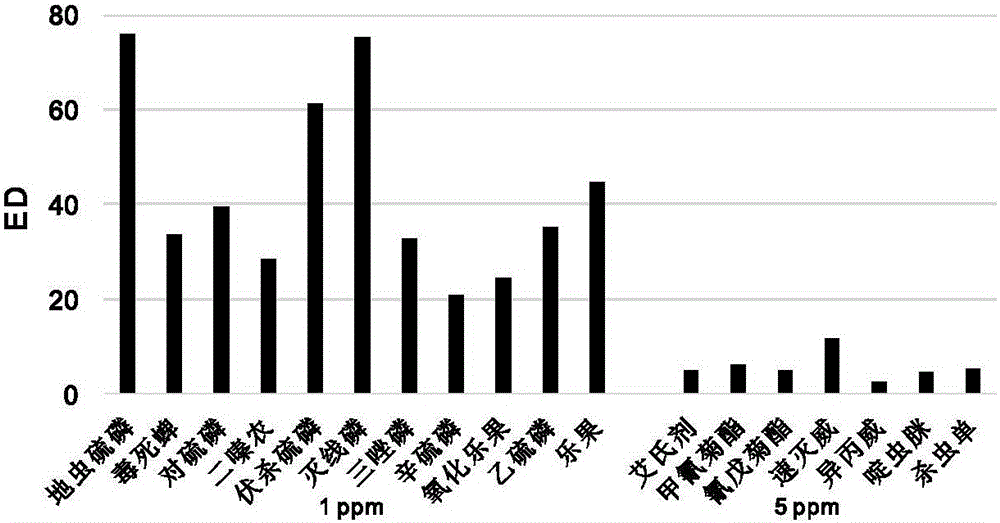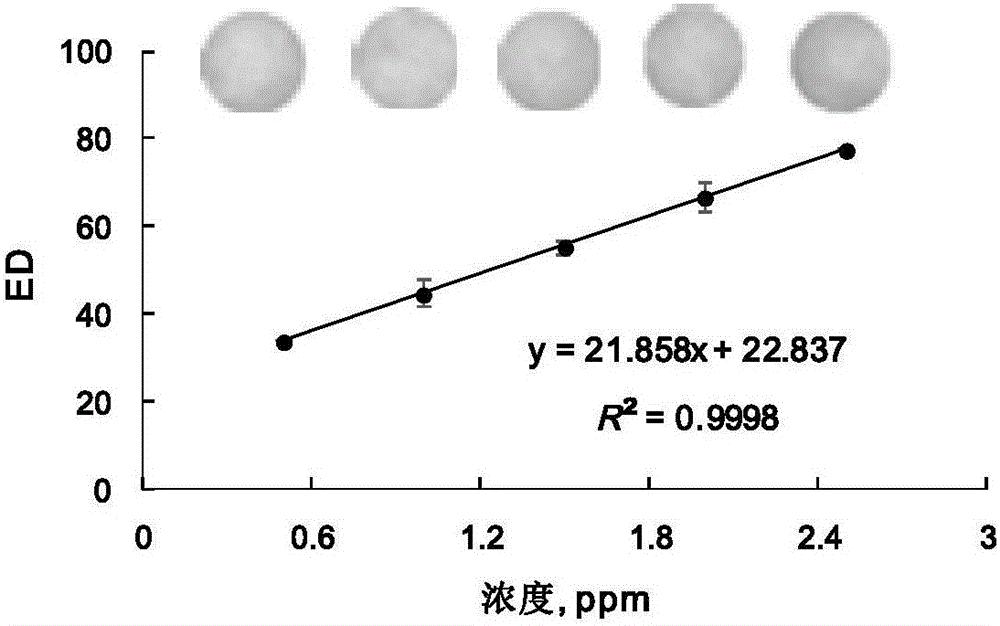Sulfur-containing organic phosphorus pesticide sensor and preparation and application thereof
A sensor and organophosphorus technology, which is applied in the field of detection of sulfur-containing organophosphorus pesticides, can solve the problems of time-consuming, false positive, cumbersome operation process, etc., and achieve the effects of improving detection sensitivity, portability, and low price
- Summary
- Abstract
- Description
- Claims
- Application Information
AI Technical Summary
Problems solved by technology
Method used
Image
Examples
Embodiment 1
[0030] Preparation of sulfur-containing organophosphorus pesticide sensor: Weigh 5 mg of palladium chloride in 1 mL of acidic silica gel sol-gel A (tetraethoxysilane: ethylene glycol methyl ether: propylene glycol methyl ether acetate: chloroform: acetic acid: koji Laton X-100: water is mixed at a volume ratio of 1:2:2:0.8:0.1:0.03:0.8, hydrolyzed at 60°C for 4 hours to obtain acidic silica gel sol-gel solution A), dissolved by ultrasonication, and then used a pipette gun Draw 1 μL of the above solution, drop-coat it on a porous filter paper with a pore size of 0.22 μm, and dry it at room temperature under the protection of nitrogen to prepare a colorimetric sensor for sulfur-containing organophosphorus pesticides.
Embodiment 2
[0032] The enrichment effect of the colorimetric sensor for sulfur-containing organophosphorus pesticides: represented by dimethoate in the sulfur-containing organophosphorus pesticides, the results are as follows figure 1 shown. It can be seen that when 200 μL of the dimethoate solution containing 1 ppm is initially dropped on the sensor, the color change of the indicator is weak, and as the volume of the added pesticide increases, the color change of the sensor gradually increases, indicating that through enrichment, the color change of the sensor can be greatly improved. The detection sensitivity of the sensor. In order to clearly distinguish the reaction, 1000 μL of the pesticide solution was used as the enrichment volume in the experiment of investigating the selectivity of the sensor and establishing the standard concentration curve in the following examples.
Embodiment 3
[0034] Selectivity of sulfur-containing organophosphorus pesticide sensors to different types of pesticides: A flatbed scanner was used to record images before and after the sensor reacted with pesticides. The pre-reaction image was defined as the sensor soaked with 1000 μL pure water, and the post-reaction image was defined as the sensor after reacting with different kinds of 1000 μL pesticides. Digitalize the color of the image before and after the reaction with Photoshop software, extract the red, green and blue (RGB) channel values, and subtract the color values of each channel before and after the reaction to obtain the color change values ΔR, ΔG, and ΔB of each channel, and then use the formula Calculate the color change value ED before and after the sensor reacts with different types of pesticides, such as figure 2 shown. From figure 2It can be seen that the sensor is sensitive to 1ppm of sulfur-containing organophosphorus pesticides (such as fenthion, chlorp...
PUM
 Login to View More
Login to View More Abstract
Description
Claims
Application Information
 Login to View More
Login to View More - R&D Engineer
- R&D Manager
- IP Professional
- Industry Leading Data Capabilities
- Powerful AI technology
- Patent DNA Extraction
Browse by: Latest US Patents, China's latest patents, Technical Efficacy Thesaurus, Application Domain, Technology Topic, Popular Technical Reports.
© 2024 PatSnap. All rights reserved.Legal|Privacy policy|Modern Slavery Act Transparency Statement|Sitemap|About US| Contact US: help@patsnap.com










